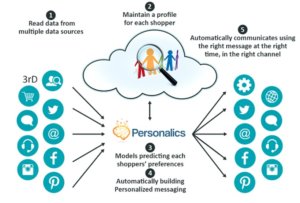In today’s online retail environment, it is hard to overemphasize the importance of personalization as a means to improving shopper experience, which in turn helps increase customer lifetime value. When done right, personalization creates a user-centric experience, leading to more meaningful and effective interactions throughout the customer journey. Personalics recently hosted a live webinar detailing the concepts and tools required to achieve successful personalization strategies.
Customer Journey
While each shopping experience differs by the type of products and services offered, and by customer segment, it is possible to break down every such experience into a progression of discrete steps, known as the customer journey. The top priority for any successful personalization strategy is to deliver the right message at the right time for each shopper throughout this journey.
And so, for example, anonymous visitors can be shown a personalized version of the website, based on third party and cookie based data; Users about to leave, can be offered special promotions; Abandoned searches can trigger a search abandonment email, and so on.
Abstraction of a few steps throughout the shopper journey
The Omni-Channel Experience
Today’s online shopper is exposed to branded and commercial content across numerous channels, such as brand websites, social media, email, and mobile, and with each comes a different behavioral pattern. Consequently, successful personalization strategies should take that into account and deliver the right message, at the right time, on the right channel, creating an all encompassing “Omni-channel” experience.
Standard personalization implementations may be able to send messages across multiple channels, but these might all be identical messages, that fail to take advantage of the channel they’re viewed in. A true omni-channel strategy, on the other hand, will provide shoppers with customized content that fits right in with the channel it’s on and tailored based on all other messages already exposed to the user. A great example of a retailer that provides users with such an experience is Amazon, which perfected this model.
While other brands are limited to specific channels or send out the same message across all channels, Amazon provides a true customer centric experience
Getting Started: Personalization Basics
Implementing a successful personalization strategy naturally comes with a set of challenges: ROI is unclear, time to implement is a factor, connecting data sources might be difficult, and resources (both budgetary and human) may be limited in house. Therefore, we advise focusing on the 80-20, where significant results can be achieved even on limited budget and resources.
Every personalization strategy should follow a few standard steps:
- Use data from multiple sources from within or outside the orgaanization
- Maintain a profile for each shopper
- Implement algorithmic models that predict each shopper’s preferences
- Based on those, automatically generate personalized messaging
- Communicate those messages at the right time, to the right channels
Advanced Tactics
Once a working personalization strategy is in place, the results should start showing. However, it is imperative to keep maintaining and evolving that strategy on an on-going basis, by layering in advanced personalization tactics.
There are numerous such tactics that can be applied to online retail, and individual results will vary. Here are a few top examples:
- Visual Storytelling – visually appealing product recommendations, based on automatically curated personalized shopping journeys. To read more about visual storytelling, click here
- Automated email triggers – messages sent after specific behavioral events
- Social media personalization – messages based on engagement patterns and interests of targeted audience segments
Following these guidelines, constantly iterating and improving, is key to implementing a sound personalization strategy and improving your bottom line. For much more on these concepts, including real-life case studies and a lively Q&A session, the full recording of this webinar is available here.




